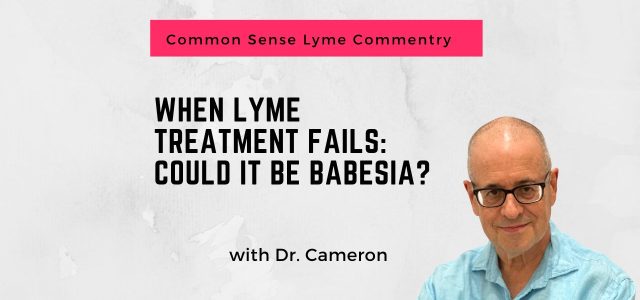
Babesia is increasingly recognized as a serious and sometimes overlooked tick-borne infection. While many patients and providers are aware of Lyme disease, they may not consider co-infections like Babesia—especially when symptoms persist after Lyme treatment. Here’s what you need to know.
Case Study 1: Missed Co-Infection
I had a patient who didn’t get better after a month of doxycycline for Lyme disease. Six months later, she was still sick, with persistent fatigue and cognitive difficulties. It turned out the deer tick bite had also transmitted Babesia—a co-infection that doxycycline alone couldn’t treat. After starting a combination of azithromycin and atovaquone, she improved significantly and eventually recovered. This case underscores the importance of identifying co-infections early, especially when symptoms don’t resolve with Lyme treatment alone.
Case Study 2: Unrecognized Transmission
Another patient unknowingly had Babesia and donated blood. The recipient of the transfusion developed Babesiosis as a result. Unlike Lyme disease, Babesia can survive in stored blood and be transmitted through transfusion. This highlights a major public health concern—many people don’t even know they’ve been infected until it’s too late.
Rising Awareness of Babesia
As we enter another summer, Babesia continues to be a growing concern as a tick-borne pathogen. The first known human case of Babesiosis caused by the Babesia microti parasite was identified in 1969 in someone who had vacationed in Massachusetts. Research by Krause and colleagues in 1998 found that 24 out of 46 untreated individuals with Babesia had detectable Babesia DNA in their blood for an average of 82 days, suggesting that asymptomatic infections can linger for months.
Serious Health Risks
Babesia can lead to serious health complications, including:
• Atrial fibrillation
• Noncardiogenic pulmonary edema
• Hemolytic anemia
Between 1982 and 1991, seven people with Babesia died in New York State. On Nantucket Island, a patient developed pancarditis—inflammation of the entire heart—and died. While most cases are mild, Babesia can be life-threatening, particularly for the elderly, immunocompromised patients, or those without a spleen.
Chronic Illness
I’ve seen patients remain chronically ill until they were diagnosed and treated for Babesia. In many cases, they had been labeled with Post Treatment Lyme Disease Syndrome (PTLDS) or were told nothing more could be done. Once Babesia was identified and treated, they improved. This reinforces the need to consider Babesia in patients who don’t respond to standard Lyme disease protocols.
Transmission Risks
Babesia is not just transmitted by tick bites. Other known transmission routes include:
- Blood transfusions – The parasite can survive in donated blood, making it a silent risk in the blood supply.
- Mother-to-child transmission – Though rare, Babesia can be passed from a pregnant woman to her unborn baby.
Pregnant women should take special precautions to avoid tick exposure and seek immediate medical care if infection is suspected.
Treatment Options
Standard Babesia treatment involves atovaquone and azithromycin, a combination that is generally well-tolerated. In more severe cases, clindamycin and quinine may be used, though side effects can be more pronounced.
Recently, tafenoquine has been introduced for patients who relapse after standard treatment. According to researchers at the Yale School of Public Health, tafenoquine can be a lifesaver, especially for immunocompromised or elderly patients who fail to respond to other treatments.
Treatment Management
The goal of Babesia treatment is to reduce the parasite load and alleviate symptoms. Here’s what’s important:
- Complete the full course of treatment to avoid relapse.
- Monitor immune-compromised patients closely, as they may need extended or repeat treatment.
- Look for coinfections, as treating Lyme alone may not be enough.
Babesia can be stubborn, and a one-size-fits-all treatment plan does not always work. Individualized care is essential.
Conclusion
Being vigilant about Babesia—especially in patients who don’t respond to Lyme disease treatment—can make a significant difference. Missed diagnoses can lead to prolonged illness, unnecessary suffering, and public health risks. Early detection, proper testing, and appropriate treatment are critical to ensure the best outcomes.



I have been seeking a diagnosis since 2017 Cleveland clinic,Mayo Clinic StLuis Missouri every where in Utah. Told small fiber after 5 years of bipolar disorder and anxiety meds really messed me up! Went into Afib due too coagulation and finally got a real test Vibrant Wellness. Babesia bart Afzellii, CSF,RMSF. A spinal tap years ago pointed towards low grade meningitis just had another one done and now red blood cells in it 3 ? I need help as the Lyme doctors here do not know about Babesia. Have me SOT for Bart? How do I get these meds when only my internist/ cardiologist believes the test also Western blot showed as well?
My legs go numb from knees down have to crawl across my house veins are calcifying no cephalic veins? Head bad with them. I have a 29 year old daughter who is special needs and needs me or I’d just give up!! Thank you!
Your story is an example of the complexity of cases I see in some patients in New York
How do I get help?
Endocrinology stuff also?
I’m asking my doctor for your protocol!!
They have all give up on me suffered another spinal Tap showed red blood cells in it a lot 3.
High protein like three years ago low and more every LLMD said low grade meningitis from years ago would not give me test results! Thank you so much for responding!! Trying to get real help never even had antibiotics.
Nine out of ten chronic neurologic Lyme disease patient had a normal spinal tap. See the 1990 article https://pubmed.ncbi.nlm.nih.gov/2172819/
How do I get a Doctor to do this treatment? Utah.
Crawling around home now losing vision?
Thank you!!
It can be challenging to find a doctor to evaluate someone for Lyme disease or co-infections if the tests are negative. Some patients reach out to organizations if their primary can’t help to include globallymealliance, Lymedisease.org or ILADS